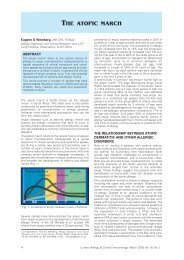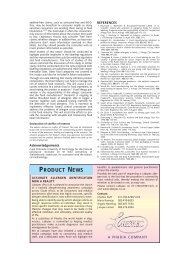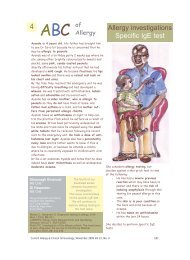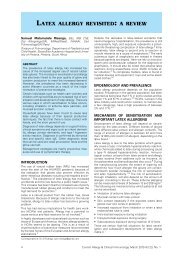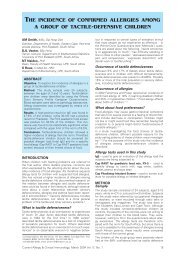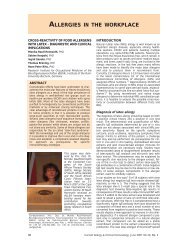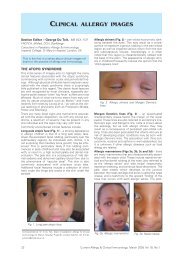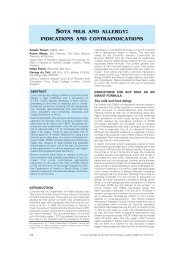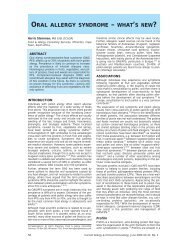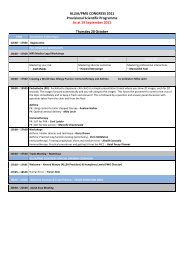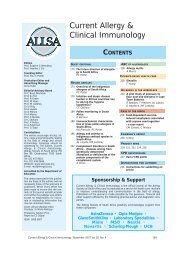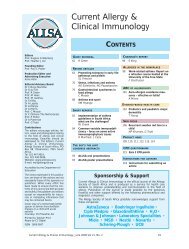Table IV. Adverse effects of IVIG therapyImmediate infusion-related* Transmission of infective agents* Consequences of increasingserum IgG †Mild to moderate reactions – Hepatitis C – several outbreaks to Renal – reversible renal impairmentheadaches, backache, chills, date; additional anti-viral step (majority of cases), acute renal failurenausea, muscle pain – occur introduced by most manufacturers in mixed cryoglobulinaemiain approximately 1% of following last outbreak in 1994infusions <strong>and</strong> are largelyHaematological – cerebal <strong>and</strong> coronaryrate-related ? Prions – potential risk; no thromboses, acute haemolysis,documented cases to dateneutropeniaSevere – anaphylaxis mayNeurological – acute aseptic meningitisoccur very rarely in IVIGDermatological – eczema, urticaria,recipients who have higherythema multiforme cutaneoustitres of anti-IgA antibodiesvasculitis*May occur with either low or high-dose IVIG; † predominantly associated with high-dose IVIG.Adapted from Jolles et al. 6 Table V. Costs of IVIG in South Africa (December 2007)more commonly associated withacute renal failure. The more important<strong>and</strong> commonly seen IVIGinducedadverse effects are summarisedin Table IV.The risk of infectious complicationsis low. There are stringent requirementsfor donor screening <strong>and</strong>transmissible disease testing. Themanufacturing process includessteps of viral inactivation orremoval to protect against infectiousagents that might be presentdespite screening procedures.Hepatitis B <strong>and</strong> HIV have neverbeen transmitted through IVIG <strong>and</strong> there is no knowncase of transmission of Creutzfeldt-Jakob disease.Since 1984 transmission of hepatitis C has been reported10 times <strong>and</strong> is estimated to have involved 4 000patients worldwide. 3 Further antiviral steps of pasteurisation,nanofiltration or solvent detergent treatmenthave been added to the manufacturing procedures todecrease this risk.IVIG is a product made from large pools of humanplasma <strong>and</strong> thus infectious disease transmissionalways remains a possibility. The risk of infection fromhuman plasma preparations can never be completelyruled out.The effect of live vaccines may be inhibited if IVIG isused. It is recommended that these vaccines be given3 months after the last dose of IVIG.COST OF IVIGIn 1997 there was a worldwide shortage of IVIG due todisruption of production caused by the need for USbasedplasma fractionators to comply with more stringentUS FDA requirements. Intravenous immuneglobulin costs between R220 <strong>and</strong> R350 per gram(depending on quantity bottled) (Table V). These costsdo not include the costs associated with administrationof IVIG.CONSIDERATIONS IN THE USE OF IVIGBecause of the cost, shortages <strong>and</strong> growing use ofIVIG there have been attempts in many countries todevelop guidelines for monitoring of <strong>and</strong> indications forthe use of IVIG. 1,7,10,27 Clinicians should limit their prescriptionof IVIG to conditions for which efficacy isPatient Schedule Cost of IVIG0.5 g/kg 2.0 g/kg20 kg child 1 dose R 2 853 R 9 0981x monthly/yr R 37 089 R 118 2741x 3-weekly/yr R 48 501 R 154 66670 kg adult 1 dose R 8 000 R 31 0001x monthly/yr R 104 000 R 403 0001x 3-weekly/yr R 136 000 R 527 000supported by evidence-based studies. In South Africa itmust be ensured that that the patients who will benefitmost from IVIG (determined from evidence-basedguidelines) will have access to this treatment. It isimportant to recognise that IVIG products vary in theircomposition <strong>and</strong> these differences have clinical implicationsparticularly when used for immunomodulation.28Although there is statutory documentation for the useof blood, there are no guidelines for the use or monitoringof IVIG in South Africa although it has beenrecognised that this would be valuable. It is advisedthat clinicians:• Document product, lot number <strong>and</strong> dose ofimmunoglobulin used in patients• Document the indication for the IVIG• Monitor liver function tests <strong>and</strong> viral screens, pretherapy<strong>and</strong> serially throughout IVIG therapy• Record any side-effects.Declaration of conflict of interestThe author declares no conflict of interest.REFERENCES1. Constantine MM, Thomas W, Whitman L, et al. Intravenousimmunoglobulin utilization in the Canadian Atlantic provinces: areport of the Atlantic Collaborative Intravenous Immune GlobulinUtilization Working Group. Transfusion 2007; 47: 2072-2080.2. Bruton OC. Agammaglobulinaemia. Pediatrics 1952; 9: 722-728.3. Chapel HM. Safety <strong>and</strong> availability of immunoglobulin replacementtherapy in relation to potentially transmissable agents. Clin ExpImmunol 1999; 118: S29-S34.4. World Health Organization. Appropriate uses of humanimmunoglobulin in clinical practice: Memor<strong>and</strong>um from anIUIS/WHO meeting. WHO Bulletin 1982: 60; 43-47.30 <strong>Current</strong> <strong>Allergy</strong> & <strong>Clinical</strong> <strong>Immunology</strong>, <strong>March</strong> <strong>2008</strong> Vol 21, No. 1
5. Ballow M. Mechanisms of action of intravenous immune serumglobulin therapy. Pediatr Infect Dis J 1994; 13: 806-811.6. Jolles S, Sewell WAC, Misbah SA. <strong>Clinical</strong> uses of intravenousimmunoglobulin. Clin Exp Immunol 2005; 142: 1-11.7. Orange JS, Hossny EM, Weiler CR, et al. Use of intravenousimmunoglobulin in human disease: A review of evidence by membersof the primary Immunodeficiency committee of the AmericanAcademy of <strong>Allergy</strong>, Asthma <strong>and</strong> <strong>Immunology</strong>. J <strong>Allergy</strong> ClinImmunol 2006; 117: S525-S553.8. Anderson D, Ali K, Blanchette V, et al. Guidelines on the use ofintravenous immune globulin for hematologic conditions. TransfusMed Rev 2007; 21: S9-S56.9. Feasby T, Banwell B, Benstead T, et al. Guidelines on the use ofintravenous immune lobulin for neurologic conditions. TransfusMed Rev 2007; 21: S57-S107.10. Robinson P, Andersen D, Brouwers M, et al. Evidence-based guidelineson the use of intravenous immune globulin for hematologic<strong>and</strong> neurologic conditions. Transfus Med Rev 2007; 21: S3-S8.11. Stiehm ER. Human intravenous immunoglobulin in primary <strong>and</strong>secondary antibody deficiencies. Paediatr Infect Dis 1997; 16: 696-707.12. Roifman CM, Gelf<strong>and</strong> EW. Replacement therapy with high doseintravenous gamma-globulin improves chronic sinopulmonary diseasein patients with hypogammaglobulinaemia. Pediatr Infect DisJ 1988; 7: S92-S96.13. Alcock GS, Liley H. Systematic review: immunoglobulin infusionfor isoimmune haemolytic jaundice in neonates. CochraneDatabase Syst Rev 2002; CD00331314. Gottstein R, Cooke RW. Systemic review of intravenousimmunoglobulin in haemolytic disease of the newborn. Arch DisChild Fetal Neonatal Ed 2003; 88: F6-F10.15. Management of hyperbilirubinaemia in the newborn infant 35 ormore weeks of gestation. Pediatrics 2004; 114: 297.16. Ferguddon D, Hutton B, Sharma M. et al. Use of intravenousimmunoglobulin for treatment of neurologic conditions: a systematicreview. Transfusion 2005; 45: 1640-1657.17. Hughes RA, Raphael JC, Swan AV, et al. Intravenous immunoglobulinfor Guillain-Barre syndrome. Cochrane Database SystematicRev 2004: CD 00206318. Berger M, Cupps T, Fauci A. Immunoglobulin replacement therapyby slow subcutaneous infusion. Ann Intern Med 1980; 93: 55-56.19. Thomas M, Brennan VM, Chap, et al. Rapid subcutaneousimmunoglobulin in children. Lancet 1993; 342: 1432-1433.20. Gardulf A, Andersen V, Bjork<strong>and</strong>er, et al. Subcutaneousimmunoglobulin replacement in patients with primary antibodydeficiencies: safety <strong>and</strong> costs. Lancet 1995; 345: 365-369.21. Fasth A, Nyström J. Safety <strong>and</strong> efficacy of subcutaneous humanimmunoglobulin in children with primary immunodeficiency. ActaPaediatr 2007; 96: 1474-1478.22. Waniewski J, Gardul A, Hammarstom L, Bioavailability of gammagobulinafter subcutaneous infusion in patients with common variableimmunodeficiency. J Clin Immunol 1994; 14: 90-97.23. Berger M. Subcutaneous immunoglobulin replacement in primaryimmunoglobulin replacement in primary immunodeficiency. ClinImmunol 2004; 112: 1-7.24. Ochs HD, Gupta S, Kiessling P, et al. Safety <strong>and</strong> efficacy of selfadministeredsubcutaneous immunoglobulin in patients with primaryimmunodeficiency diseases. J Clin Immunol 2006; 26:265-273.25. Chapel HM, Spickett GP, Ericson D. et al. The comparison of theefficacy <strong>and</strong> safety of intravenous versus subcutaneousimmunoglobulin replacement therapy. J Clin Immunol 2000; 20: 94-100.26. Pierce LR, Jain N. Risks associated with the use of intravenousimmunoglobulin. Transfus Med Rev 2003; 17: 241-251.27. Australian Health Ministers Advisory Council. Review of the use<strong>and</strong> supply of intravenous immunoglobulin in Australia. A report bythe Blood <strong>and</strong> Blood Products Committee. June 2000.htpp://www.nba.gov.au/pubs/_pdf.ivig.pdf (last accessed: 15February <strong>2008</strong>).28. Vo AA, Cam Vi, Toyada M, et al. Safety <strong>and</strong> adverse events profilesof intravenous gammaglobulin products used for immunomodulation:a single center experience. Clin J Am Soc Nephrol 2006; 1:844-852.<strong>Allergy</strong> <strong>and</strong> <strong>Immunology</strong> Secrets 2/ewith STUDENT CONSULT Online AccessM. Eric Gershwin, MD <strong>and</strong> Stanley M. Naguwa, MD2005, softcover, 352 pp, 19 illus., Mosby, R490As the number of asthma <strong>and</strong> immunodeficiency cases continues to rise, thoroughknowledge of immunologic processes is becoming increasingly important. Despitethe seemingly small number of chapters, each chapter provides comprehensivecoverage of all the topics necessary to pass the allergy-clinical immunology boardsin the easy-to-use Secrets format. Chapters include epidemiology, pathophysiology,asthma, sinusitis, urticaria/angioedema, atopic dermatitis, anaphylaxis, food allergy/intolerance, insect allergy, drug hypersensitivity, immunodeficiency, <strong>and</strong> systemicmast cell disease. The smart way to study! Elsevier titles with STUDENT CONSULTwill help you master difficult concepts <strong>and</strong> study more efficiently in print <strong>and</strong> online!Perform rapid searches. Integrate bonus content from other disciplines. Downloadtext to your h<strong>and</strong>held device. And a lot more. Each STUDENT CONSULT title comeswith full text online, a unique image library, case studies, USMLE style questions,<strong>and</strong> online note-taking to enhance your learning experience.Key features Excellent preparation for allergy-clinical immunology boards. Includes a chapter on alternative medicine treatments for allergy. All the most important “need-to-know”, questions-<strong>and</strong>-answers in the proven format of the highlyacclaimed Secrets Series® Concise answers that include the author’s pearls, tips, memory aids, <strong>and</strong> “secrets” Bulleted lists, algorithms, <strong>and</strong> illustrations for quick review Thorough, highly detailed index Thought-provoking questions that provide succinct answers Presentation of a vast amount of information, but not overly simplistic.Orders: Medical Book Seller, Tel Jackie: 083 303 8500, fax (021) 975-1970,E-mail: jackie@medbookseller.co.za<strong>Current</strong> <strong>Allergy</strong> & <strong>Clinical</strong> <strong>Immunology</strong>, <strong>March</strong> <strong>2008</strong> Vol 21, No. 1 31



